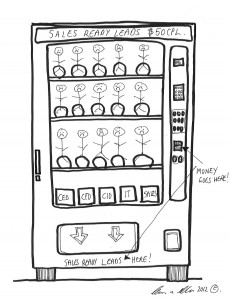 If you talk to a publisher or lead generation firm, it would seem leads have become a commodity. Nearly every B2B publisher offers lead generation under a broader heading of demand generation.
If you talk to a publisher or lead generation firm, it would seem leads have become a commodity. Nearly every B2B publisher offers lead generation under a broader heading of demand generation.
Here is a hypothetical, yet very realistic, snippet of a conversation with a publisher:
Marketer: We are looking for demand generation opportunities that will deliver leads for sales.
Publisher: Sure, we have a number of programs that will do that! What is your target audience?
Marketer: Rattles off target industry, role and seniority. Oh, and we have two new white papers we can use in this program.
Publisher: No problem, we can do that. How many leads do you need and when do you need them by?
Marketer: 500 by the end of the quarter.
Publisher: Shouldn’t be a problem, I will confirm inventory and get back to you tomorrow.
Can Lead Generation Be This Easy?
There are a number of things to note in this conversation:
- There is no discussion of lead criteria, only audience criteria.
- Leads are just an inventory line, driven by the number of available leads a publisher can provide.
- There is no assessment of the quality of the content used in the promotions.
- Actually creating demand is completely ignored.
At best, the resulting program is a list of relatively targeted contacts, not leads that are qualified and appropriate to pass to a sales team as leads.
Publishers actively promote the perception that they deliver leads. Here is a particularly aggressive quote from one company’s website:
We use your content and our database of over 20 million business contacts to manufacture marketing qualified leads for your business.
As many leads as you want, whenever you want them. That’s our promise. (emphasis added)
Developing Real Leads
These are not leads. They are marketing contacts or campaign responders with no defined need, authority or intent.
Any marketer with an open wallet can license someone else’s content, pay to have it promoted and capture registrations. The work is turning contacts into real leads.
Developing leads from these contacts requires three additional steps.
1. Creating awareness at an individual level
If someone is not open to a solution from your company, they will not buy from you. If they do not know your company or solution exists, they cannot be open to your solution.
The individuals you are targeting need to know you exist. (Note this is not about general awareness, that is a topic for another post).
2. Educate and address concerns with proactive nurturing
Your contacts are just contacts. Many may not have an understanding of the types of solutions available or how to select the right one. Some will not have recognized a need or opportunity yet.
Nurturing fills this gap. You need to provide the information they need, answer the questions they have and proactively address concerns that may be raised.
Do not limit nurturing to just content distributed by email. Nurture can encompass all targeted marketing or sales communication and may deliver the individual awareness needed.
3. Qualify potential prospects
BANT, or budget, authority, need and timing, is still the standard for lead qualification, although many companies are successfully predicting elements of BANT qualification using behavior (certain types of content downloaded, questions asked, etc).
Regardless of the approach used, contacts need to be evaluated, and often re-evaluated over time, against specific criteria to determine if they are leads that are appropriate for sales.
Summary
Turning contacts into leads is hard work. Sadly, there is no vending machine for marketing qualified leads.
Like your mother said, if it sounds to good to be true, it probably is.
Drawing by Kenny Madden. Used with Permission.

Pingback: Sourcing3 Buyer & Supplier Magazine - Best of B2B Marketing Zone for Week of May 12, 2012()